How Metrolinx separates trains from car traffic
Transit agency is improving or upgrading level crossings across GO Transit’s network.
Jun 28, 2018
There’s almost nothing worse for drivers, cyclists or pedestrians than being in a hurry to get somewhere, only to be stopped in their tracks. Or close to the tracks in some cases. Hearing that familiar “ding, ding, ding” while on the road and seeing those railway crossing arms come down, can be a major inconvenience.
That’s part of the reason for improving or upgrading more than 180 level crossings across GO Transit’s network. Major bridge work and grade separations are needed to make room for more trains and more service for customers in the near future.
Right now, Metrolinx is in the midst of a massive GO expansion that will see the number of trains increase substantially over the next 5 to 7 years. To help accommodate the extra train service and prevent potential transportation bottlenecks, the transit agency is building more than 10 major grade separations across the GTHA.
Grade separations are created to allow trains to pass over or under vehicular traffic, eliminating the need for different modes of transportation to cross each other. These are massive feats of engineering which can cost between $25-million to $100-million, depending on the size and scope of the project.
Strachan Avenue grade separation was completed in 2015.
A number of grade separation bridges across the region have already been completed, including projects at Strachan Avenue in Toronto and Ford Drive in Oakville.
The plan for Burloak Drive in Oakville involves construction crews temporarily moving a 4-lane arterial road several metres to the east. They will then bury it so that a rail-bridge can be built over the road. All nearby utilities will also have to be relocated, including sewers, hydro and natural gas lines.
Three GO train tracks will be shifted south at Burloak Drive in Oakville during construction for a new grade separation bridge.
Metrolinx Chief Capitol Officer Peter Zuk says the implementation of the GO Expansion program will not only increase the amount of service for transit customers, but improve the speed and frequency of the rail network. In order to safely support more trains though, it’s crucial for vehicle and train traffic to be separated where possible.
“Work has already started on a number of these critical infrastructure projects on the Barrie and Lakeshore Corridors,” said Zuk. “We are also working with municipalities to assess opportunities for additional grade separations on the Stouffville GO corridor.”
As for the crossings that won’t be separated, Metrolinx has developed a plan for upgrades, as well as several safety and education initiatives.
So the next time those lights start flashing and the arms come down at a rail crossing, know that the day will soon come when more GO trains are moving more passengers, while other modes of transportation can carry on without disruption.
